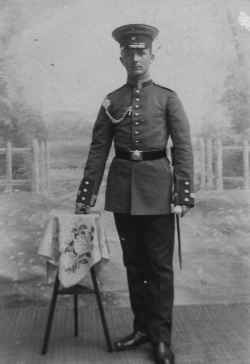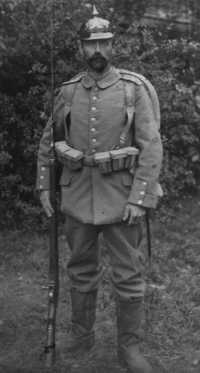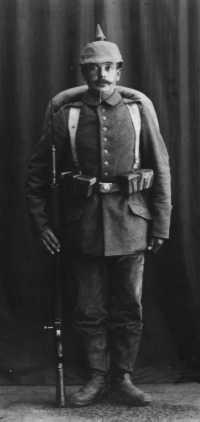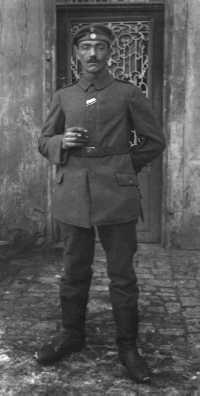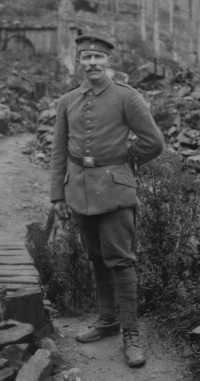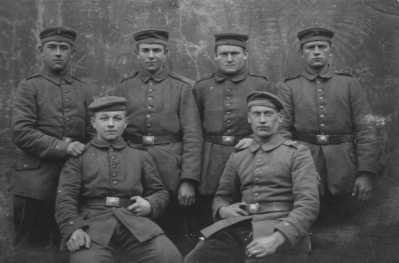
| Back | Special | Library | Search | Home | Help |
Wartime Changes to the German Field Uniform 1914-1916
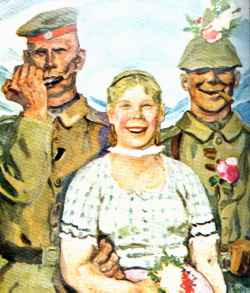 |
| German mobilization drawing, 1914. |
Contributed by

Ralph Reiley (Reileys@worldnet.att.net)
Wartime Changes to the German Field Uniform 1914-1916
This is a short discussion on the modifications to the 1910 field
uniform. There is not enough space here to fully document all
the variations in German uniform standards, so this piece is
limited to the typical infantry uniform. The growth of the German
Army from 1870 to 1914, was a quartermaster's nightmare in supply
for all the different types of helmets and uniforms for all the
various German regiments and branches of service. Until 1910,
each German state had its own particular uniform color, belt buckle
motto, and a bewildering variety of badges, armbands, and helmet
plates so that each particular Regiment had some distinctive or
unique characteristic to commemorate some past battle or other
distinction bestowed upon it. Sometimes there were unique distinctions
inside regiments. Some regiments had a Leib (Guard) Company.
Another example is the grand duchy of Brunswick, the home of
the 92nd infantry regiment. The 3rd battalion wore a small silver
death's head plate over the brass Prussian helmet plate that the
1st & 2nd battalions were not entitled to wear. In 1910, the
entire German army adopted the Feldgrau uniform, while
maintaining all State and Regimental variations. The pre-1910
uniforms were also maintained for parades, law court, guard duty,
social affairs and for "walking-out", or off-duty times.
The military luxury of maintaining the variety of uniforms could
only be supported under peacetime conditions. The outbreak of
war forced the German army to simplify it's field uniform. This
occurred twice in 1915, and again in 1917.
This is a photo of a young Prussian N.C.O. circa 1912 in his dress
uniform. His tunic is Dunkelblau (Dark Blue), his trousers
are black with red side seam piping. The dark band of his hat,
the standing collar and Brandenburg cuff are red. The lace trim
at the collar and cuff is gold, and indicates his rank as an N.C.O.
The lack of N.C.O. disks on the collar indicate his rank as Unteroffizier,
a rank between corporal and Sergeant. He is wearing a marksman's
lanyard with one acorn, the lowest qualification as a marksman.
His belt buckle is brass with a silver badge in the center, unchanged
since 1847. The badge has the Prussian king's crown in the center
and the Prussian State Motto, Gott Mit Uns (God is With
Us), surrounding the crown. He is wearing a bayonet and bayonet
knot. The colored bands of the bayonet knot would indicate which
company this soldier belonged to. The buttons on his shoulder
boards would also have the company number on them.
A photo of a young Prussian Einjährig-freiwillige
(One-year Volunteer), circa 1903. His uniform is blue with a
red standing collar. The black braid on the white piping of his
shoulder boards was worn only by a Prussian One-year Volunteer,
each State. The One-year Volunteer served 12 months in boot
camp as a private and paid all his own expenses for food, clothing,
and equipment. At the end of the year, he would have been transferred
to the Reserve as an "aspirant officer", and upon completion
of a two year training course would receive his first lieutenant's
commission in the reserve. This was a method that a financially
secure middle class family could raise their social standing in
the somewhat rigid German social scene.
This is a Bavarian reservist, called up for service late in 1914.
He is wearing the standard 1910 Fieldgrey wool uniform with Brandenburg
cuffs, piped in red, and the Stehumfallkragen (stand and
fall collar), a very uncomfortable back pack and leather jackboots,
unchanged since 1870. The outside seam of his Fieldgrey trousers
would also have been piped in red. The buttons on his tunic have
the Bavarian rampant lion in place of the Prussian crown. He
is wearing a leather or enameled tin pickelhaube with a brass
Bavarian state helmet plate, spike, and trim. The disks on his
collar, and lack of N.C.O. lace at the collar and cuff indicate
his rank as Gefrieter (lance corporal). Fixed to his rifle
is the obsolete quill, or feather, bayonet, it has a very thin
blade and is over 24 inches long. Later the bayonet was altered
to have a shorter and wider blade, the so called 'butcher' bayonet,
as its shape resembled the large knife a butcher would use. His
3 section leather ammo pouches hold fifteen rounds in each section
for a total of ninety rounds, a further one hundred and fifty
rounds were carried in the pack. His belt buckle is iron and
painted field grey. The badge in the center of the buckle has
the Bavarian king's crown surrounded by the Bavarian State motto,
In Treue Fest (In Loyalty Steadfast).
This photo was taken in mid 1915. The soldier's Pickelhaube
(spiked helmet) is covered with the canvas cover. Pre-war helmet
covers would have had the regimental number indicated by a large
red Arabic number. In 1914, the color of the number was changed
to dark green, and in 1915, it was left off altogether. The leather
used in the helmet was imported from Argentina. In 1914, the
British blockade caused the first shortage of the war, leather
for helmets. Felt and fibre board as well as tin or sheet metal
was used as substitute materials for making helmets. Spiked helmets
continued to be produced for enlisted men until the spring of
1916, when the Stahlhelm, (steel helmet), was introduced.
The soldier is wearing the 1915 Transitional tunic. A wartime
measure simplified the tunic and eliminated the complex Brandenburg
and Swedish cuffs of the 1910 uniform and replaced them with simple
turn back cuffs. This style cuff was well liked by the soldiers,
as all military passes and other I.D. required to be shown to
military authorities could be conveniently stowed away in the
fold of the wide turn back cuff. Up to the end of the war the
1910, Transitional and 1915 Bluse type tunics continued to be
produced. The soldier's belt buckle is the pre-war brass and
silver type. Attached to his rifle is the shorter, butcher bayonet.
This photo is an example of a Bavarian soldier, circa 1917, wearing
the 1915 Bluse type wool tunic. The cuffs turn back as in the
Transitional tunic, and the brass buttons of the 1910 and Transitional
tunics have been replaced with a fly front that concealed the
simple buttons of horn; later in the war, wood, bakelite, or any
ersatz materials were used for buttons. All metals were becoming
scarce by 1916. As a result the only visible buttons on the tunic
are tour zinc buttons, two at the shoulder boards and two at the
tunic pockets. The soldier is wearing the standard German enlisted
man's Feldmütze (field cap), a visorless hat. An N.C.O.
would wear a similar style hat, but with a small leather visor.
The feldmütze was field grey wool, with a colored band on
the bottom, red for infantry, green for Jägers (light infantry),
and black for artillery and Pioneers (combat engineers). In late
1915 a grey canvas camouflage strip was issued to be tied around
the red band on the feldmütze. There are two colored buttons
on the feldmütze. The top button indicated the German army,
the bottom button indicated what German State the soldier served.
The top button is Black, White, and Red, the national colors
of Germany. The bottom button is White, Blue, White, the State
colors of Bavaria. Each state had its own colors, Prussian colors
were White and Black. The soldiers belt buckle is iron, but
painted black. In 1915, an order from the Kaiser changed the
traditional brown finish of leather boots, belts and other gear
to black, and belt buckles were painted black after this. Bavaria
did not change to black leather until 1916. The ribbon on the
soldier's tunic is the Bavarian Militärverdienstorden
(Military Service Order), the Bavarian equivalent to the Iron
Cross. In the field only the ribbon was worn, the medal was sent
home for safekeeping.
This Prussian soldier is somewhere near the front lines, but not
too near or he would be carrying a gas mask in an airtight metal
can. He is wearing the feldmütze, with the canvas camouflage
strip, the 1915 Transitional tunic, and ankle boots with Gamaschen
(Puttees). Leather for boots was in short supply to the German
army. Soldiers were paid a bounty if they provided their own
boots, which were usually lace up ankle boots, as illustrated
here. Most storm trooper units wore this style boot in place
of the clumsy jackboots. The soldier is wearing a brass and silver
belt buckle. This soldier is off-duty but still carries his bayonet.
A German soldier was always armed, even when off duty. Later
in the war a trench dagger often replaced the bayonet for off
duty times. The ribbon on his tunic is for the Prussian Eiserne
Kreuz II Klasse (Iron Cross II class). In the field, only
the ribbon was worn in the second button hole as this soldier
does, while the medal would have been sent home. The Iron Cross
1st class had no ribbon and was generally only awarded to officers
who had previously been awarded the 2nd class medal. On rare
occasions the 1st class medal would be awarded to an enlisted
man.
A group of young soldiers from Wurtemburg pose in the photographer's
studio. They are members of the 248th Regiment, a new unit created
after 1916. The soldier seated on the right, and the others standing
behind are wearing dark brown corduroy trousers. By 1916, many
private purchase items began to supplement standard government
issue clothing and boots, which were becoming more difficult to
supply on a regular basis. The corduroy trousers were popular
with mountain climbers, and soon with soldiers in the trenches
as well. There were two types of corduroy trousers, regular straight
leg trousers and a type similar to knickers in that they were
loose down to below the knee, then they fit close to the calf,
which worked well with ankle boots and Gamaschen. All of the
soldiers are wearing the feldmütze with the camouflage strip,
the state colors of the lower button was black, red, black..
Their tunics are the standard 1910 uniform with Swedish cuffs
and the 1915 Transitional type. They all are wearing the brass
and silver belt buckle, with the Wurtemburg king's crown surrounded
by the state motto, Furchtlos und Treu (Fearless and True).
This is a very brief survey of the changes to the German infantryman's uniform and it is hoped that this short discussion is of interest. © 1997 Ralph Reiley - All rights reserved |
